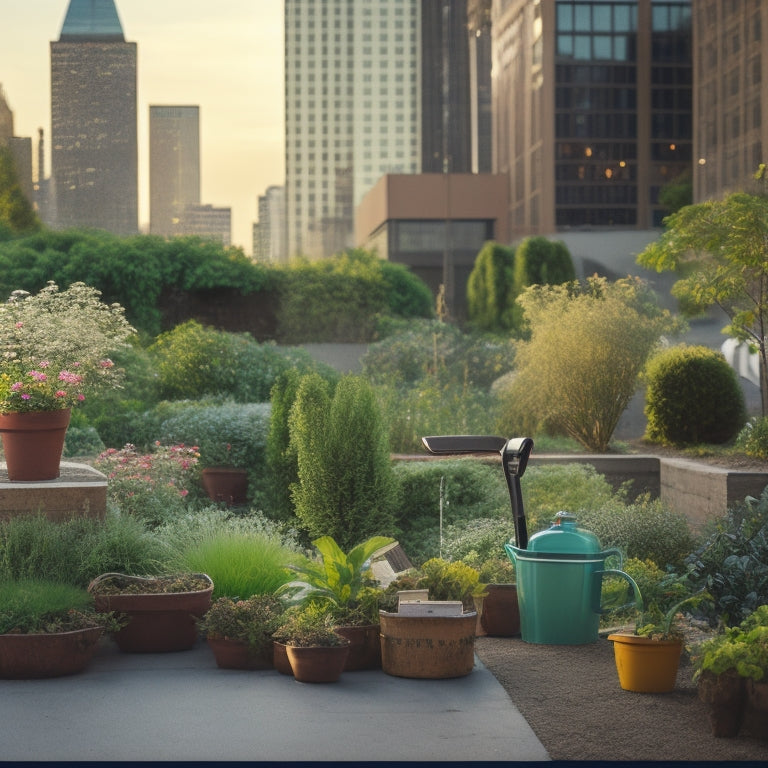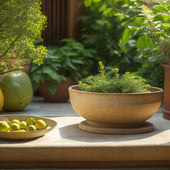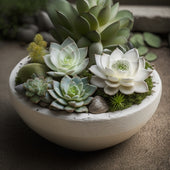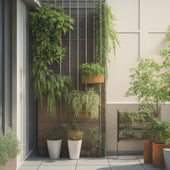
What to Know Before Planting a City Garden
Share
Before planting a city garden, you'll want to take into account several key factors. First, choose a location that gets at least six hours of direct sunlight and is close to a water source. Assess the soil quality, as urban areas often have contaminated or poor soil, and be prepared to take remediation steps if necessary. Understand the unique urban climate conditions, including the heat island effect and pollution, and select vegetable varieties that are suited to these conditions. You'll also need to manage limited space effectively, deal with shade challenges, and develop a watering strategy that conserves water. By understanding these urban gardening challenges, you'll be well on your way to a thriving city garden - and there's more to learn to guarantee your success.
Key Takeaways
• Assess the garden location considering sunlight exposure, proximity to water source, accessibility, and obstacles for a successful garden.
• Test the soil for contamination and composition issues, and use remediation strategies like raised beds or container gardens if necessary.
• Choose vegetable varieties that are tolerant to urban climate conditions, have compact growth, and are resistant to pests.
• Manage limited space effectively by using vertical gardening, container gardening, and tiered planters to maximize growth.
• Adopt efficient watering strategies such as rainwater harvesting, drip irrigation, and soil moisture monitoring to conserve water in urban environments.
Choosing the Right Garden Location
When selecting a garden location, consider the amount of sunlight your plants will need, as most vegetables and flowers require at least six hours of direct sunlight per day.
You'll want to choose a spot that gets ideal sunlight exposure, especially if you're planning to grow sun-loving plants like tomatoes or squash.
Proximity factors also play a significant role in determining the right garden location. Consider the distance between your garden and your water source, as well as the proximity to your kitchen or storage areas.
You'll want to minimize the distance you need to haul water, tools, and harvested produce.
Additionally, think about the accessibility of the location. Will you be able to easily reach the garden from your back door or balcony?
Are there any obstacles, such as trees or power lines, that might interfere with your gardening plans?
By carefully evaluating these factors, you can choose a garden location that sets you up for success and makes gardening a joy.
Assessing City Soil Quality Issues
Now that you've chosen the perfect spot for your city garden, it's time to get down to earth - literally!
You'll need to assess the soil quality to guarantee it's safe and suitable for your plants.
You should be aware of potential soil contamination concerns and understand the unique composition of urban soil to give your garden the best possible start.
Soil Contamination Concerns
You'll likely encounter contaminated soil when planting a city garden, as urban areas often harbor pollutants like heavy metals, pesticides, and industrial waste that can leach into the soil. These contaminants can harm your plants, and even your health if you consume them. It's vital to identify the sources of contamination to take corrective action.
Common contamination sources include old industrial sites, nearby construction projects, and even previous uses of your property, such as a gas station or dry cleaner. Soil testing is necessary to determine the type and level of contaminants present. You can purchase DIY soil testing kits or hire a professional to conduct a more thorough analysis.
When interpreting your soil test results, look for signs of heavy metals, pesticides, and industrial pollutants. If your soil is contaminated, you may need to remediate the soil or take steps to mitigate the risks, such as using raised beds or container gardens.
Urban Soil Composition
Urban soil composition often varies considerably from its rural counterpart, featuring a mix of debris, construction materials, and other foreign objects that can compromise its quality and fertility.
As you prepare to plant your city garden, it's crucial to assess the soil quality issues that may hinder plant growth. You'll likely encounter compacted soil, poor drainage, and a lack of organic matter. To overcome these challenges, you'll need to incorporate soil amendments that improve soil structure, fertility, and overall health.
Urban composting is an excellent way to create nutrient-rich soil amendments. By composting food waste, leaves, and other organic materials, you can create a natural fertilizer that enriches your soil.
Additionally, consider adding organic matter like peat moss, composted manure, or worm castings to improve soil structure and fertility. When selecting soil amendments, choose products specifically formulated for urban gardens, as they're designed to address the unique challenges of city soils.
Selecting Suitable Vegetable Varieties
What type of vegetables will thrive in your city garden, given the local climate and available space? As you plan your garden, it's vital to choose varieties that are well-suited to your specific conditions. Heirloom varieties, for instance, can add unique flavors and textures to your harvest, but may require more care and attention.
When selecting vegetables, consider the following factors:
-
Climate tolerance: Look for varieties bred for your region's temperature and moisture ranges.
-
Space constraints: Compact or dwarf varieties are perfect for small city gardens.
-
Pest resistance: Choose varieties with built-in defenses against common urban pests.
-
Companion planting: Select vegetables that benefit from each other's growth, like the classic 'Three Sisters' combination of corn, beans, and squash.
-
Days to maturity: Opt for varieties with shorter maturation periods to guarantee a timely harvest.
Understanding Urban Climate Conditions
By familiarizing yourself with the unique climate conditions found in cities, such as the urban heat island effect and pollution, you can better prepare your garden to thrive.
The urban heat island effect, caused by pavement, buildings, and vehicles, can raise temperatures by up to 10°F (5°C) compared to surrounding rural areas. This can lead to heat stress in plants and alter their growth patterns. Additionally, pollution from vehicles and industrial activities can contaminate soil and water, affecting plant health.
To mitigate these effects, it's crucial to identify microclimates within your city garden. Microclimates are small areas with distinct climate conditions, such as shade, wind, or sun exposure.
By understanding these microclimates, you can choose plants that are well-suited to the specific conditions, increasing their chances of success. For example, plants that thrive in shade can be placed in areas with limited sunlight, while heat-tolerant plants can be placed in areas with high urban heat.
Managing Limited Space Effectively
You'll likely face the challenge of limited space in your city garden, where every inch counts. To maximize your space, consider the following strategies:
Vertical gardening: train vining plants like peas, beans, or tomatoes to grow up trellises or walls, freeing up ground space for other plants.
Container gardening: use pots, planters, or window boxes to grow herbs, flowers, or vegetables on balconies, rooftops, or patios.
Use tiered planters or stair-step gardens to create multiple levels of planting space.
Choose compact varieties of plants that are bred specifically for small spaces.
Opt for space-saving supports like obelisks or cages to keep plants upright and organized.
Dealing With City Shade Challenges
Shade from tall buildings or trees can limit the amount of sunlight your city garden receives, but don't let that stop you from growing a thriving garden. You can still create a beautiful and productive space by choosing shade-tolerant plants. These plants are adapted to thrive in low-light conditions and can add color, texture, and interest to your garden. Consider plants like ferns, hostas, and impatiens, which can tolerate partial shade.
Another solution is to use vertical gardening techniques to maximize the available sunlight. By training vining plants like ivy, clematis, or morning glories to grow up trellises or walls, you can make the most of the sunlight that filters through. This approach also adds depth and visual interest to your garden.
Additionally, consider using mirrors or reflective surfaces to bounce sunlight onto shaded areas, creating the illusion of more light. With a little creativity and planning, you can overcome the challenges of city shade and create a thriving and beautiful garden.
Watering in Urban Environments
As you've optimized your city garden for shade, it's equally important to contemplate how urban environments impact watering, since nearby buildings and pavement can absorb or redirect rainfall, affecting soil moisture. In urban settings, it's essential to adopt efficient watering strategies to conserve this precious resource.
To water wisely, consider the following:
-
Rainwater harvesting: Collect and store rainwater in barrels or tanks to reduce your reliance on municipal water supplies.
-
Drip irrigation: Use this method to deliver water directly to plant roots, minimizing evaporation and runoff.
-
Soil moisture monitoring: Regularly check soil moisture levels to avoid overwatering, which can lead to disease and pest issues.
-
Drought-tolerant plants: Choose plants adapted to thrive in dry conditions, reducing the need for frequent watering.
-
Water-efficient scheduling: Water during cooler parts of the day to minimize evaporation, and avoid watering during strong winds or intense sunlight.
Preparing for Common Pests
In city gardens, pests can quickly spiral out of control, so it's crucial to take proactive measures to prevent infestations and protect your plants from damage.
As you prepare your city garden, you'll want to familiarize yourself with common pests and learn how to identify them. Aphids, whiteflies, and spider mites are just a few of the culprits that can wreak havoc on your plants.
You'll want to monitor your plants regularly for signs of infestation, such as holes in leaves, sticky residue, or actual pests on the plants. Once you've identified the pest, you can start treating the issue.
Organic remedies like neem oil, insecticidal soap, and horticultural oil are effective and environmentally friendly ways to combat pests. You can also introduce beneficial insects, like ladybugs and lacewings, which prey on common garden pests.
Frequently Asked Questions
How Do I Handle Garden Waste and Compost in a Small City Space?
As you coincidentally collect coffee grounds and veggie scraps, consider compact composting methods, like vermicomposting or bokashi, and implement smart waste management strategies to efficiently turn trash into nutrient-rich soil for your thriving city garden.
Can I Grow a City Garden in a Yard With Underground Utilities?
Before digging, you'll need to map underground utilities to avoid damaging them. Then, choose plants with shallow roots or those that thrive in containers to guarantee a safe and thriving city garden.
Are City Gardens Susceptible to Pollution From Nearby Traffic?
As you breathe in the urban jungle's air, you're inhaling a cocktail of pollutants from nearby traffic, which can taint your city garden's soil and air quality. Urban planning strategies can help mitigate this impact, but it's essential you're aware of the risks.
How Do I Protect My City Garden From Curious Pets and Wildlife?
To safeguard your city garden, you'll want to explore fencing options, like chicken wire or metal mesh, and choose pet-friendly plants that won't harm curious critters, ensuring a harmonious coexistence between wildlife and your green oasis.
Can I Have a City Garden if I Rent My Home or Apartment?
You can still have a city garden if you rent, but check your rental agreements first. Consider container gardening, which is portable and doesn't alter the property, making it a great option for renters.
Related Posts
-

10 Natural Ways to Clean Your Planters
You can transform your planters from grimy to gleaming with these 10 natural cleaning solutions. Mix baking soda and ...
-

10 Natural Ways to Clean Your Planters
You can transform your planters from grimy to gleaming with these 10 natural cleaning solutions. Mix baking soda and ...
-

10 Natural Ways to Clean Your Planters
You can transform your planters from grimy to gleaming with these 10 natural cleaning solutions. Mix baking soda and ...
-

10 Natural Ways to Clean Your Planters
You can transform your planters from grimy to gleaming with these 10 natural cleaning solutions. Mix baking soda and ...
-

10 Natural Ways to Clean Your Planters
You can transform your planters from grimy to gleaming with these 10 natural cleaning solutions. Mix baking soda and ...
-

10 Natural Ways to Clean Your Planters
You can transform your planters from grimy to gleaming with these 10 natural cleaning solutions. Mix baking soda and ...
-

10 Natural Ways to Clean Your Planters
You can transform your planters from grimy to gleaming with these 10 natural cleaning solutions. Mix baking soda and ...
-

10 Natural Ways to Clean Your Planters
You can transform your planters from grimy to gleaming with these 10 natural cleaning solutions. Mix baking soda and ...
-

10 Natural Ways to Clean Your Planters
You can transform your planters from grimy to gleaming with these 10 natural cleaning solutions. Mix baking soda and ...
-

10 Natural Ways to Clean Your Planters
You can transform your planters from grimy to gleaming with these 10 natural cleaning solutions. Mix baking soda and ...
-

10 Natural Ways to Clean Your Planters
You can transform your planters from grimy to gleaming with these 10 natural cleaning solutions. Mix baking soda and ...
-

10 Natural Ways to Clean Your Planters
You can transform your planters from grimy to gleaming with these 10 natural cleaning solutions. Mix baking soda and ...
-

10 Natural Ways to Clean Your Planters
You can transform your planters from grimy to gleaming with these 10 natural cleaning solutions. Mix baking soda and ...
-

10 Natural Ways to Clean Your Planters
You can transform your planters from grimy to gleaming with these 10 natural cleaning solutions. Mix baking soda and ...
-

10 Natural Ways to Clean Your Planters
You can transform your planters from grimy to gleaming with these 10 natural cleaning solutions. Mix baking soda and ...
-

10 Natural Ways to Clean Your Planters
You can transform your planters from grimy to gleaming with these 10 natural cleaning solutions. Mix baking soda and ...
-

10 Natural Ways to Clean Your Planters
You can transform your planters from grimy to gleaming with these 10 natural cleaning solutions. Mix baking soda and ...
-

10 Natural Ways to Clean Your Planters
You can transform your planters from grimy to gleaming with these 10 natural cleaning solutions. Mix baking soda and ...
-

10 Natural Ways to Clean Your Planters
You can transform your planters from grimy to gleaming with these 10 natural cleaning solutions. Mix baking soda and ...
-

10 Natural Ways to Clean Your Planters
You can transform your planters from grimy to gleaming with these 10 natural cleaning solutions. Mix baking soda and ...
-

10 Natural Ways to Clean Your Planters
You can transform your planters from grimy to gleaming with these 10 natural cleaning solutions. Mix baking soda and ...
-

10 Natural Ways to Clean Your Planters
You can transform your planters from grimy to gleaming with these 10 natural cleaning solutions. Mix baking soda and ...
-

10 Natural Ways to Clean Your Planters
You can transform your planters from grimy to gleaming with these 10 natural cleaning solutions. Mix baking soda and ...
-

10 Natural Ways to Clean Your Planters
You can transform your planters from grimy to gleaming with these 10 natural cleaning solutions. Mix baking soda and ...
-

10 Natural Ways to Clean Your Planters
You can transform your planters from grimy to gleaming with these 10 natural cleaning solutions. Mix baking soda and ...
-

10 Natural Ways to Clean Your Planters
You can transform your planters from grimy to gleaming with these 10 natural cleaning solutions. Mix baking soda and ...
-

10 Natural Ways to Clean Your Planters
You can transform your planters from grimy to gleaming with these 10 natural cleaning solutions. Mix baking soda and ...
-

10 Natural Ways to Clean Your Planters
You can transform your planters from grimy to gleaming with these 10 natural cleaning solutions. Mix baking soda and ...
-

10 Natural Ways to Clean Your Planters
You can transform your planters from grimy to gleaming with these 10 natural cleaning solutions. Mix baking soda and ...
-

10 Natural Ways to Clean Your Planters
You can transform your planters from grimy to gleaming with these 10 natural cleaning solutions. Mix baking soda and ...
-

10 Natural Ways to Clean Your Planters
You can transform your planters from grimy to gleaming with these 10 natural cleaning solutions. Mix baking soda and ...
-

10 Natural Ways to Clean Your Planters
You can transform your planters from grimy to gleaming with these 10 natural cleaning solutions. Mix baking soda and ...
-

10 Natural Ways to Clean Your Planters
You can transform your planters from grimy to gleaming with these 10 natural cleaning solutions. Mix baking soda and ...
-

10 Natural Ways to Clean Your Planters
You can transform your planters from grimy to gleaming with these 10 natural cleaning solutions. Mix baking soda and ...
-

10 Natural Ways to Clean Your Planters
You can transform your planters from grimy to gleaming with these 10 natural cleaning solutions. Mix baking soda and ...
-

What Makes a Great Planter for Succulents
When selecting a great planter for succulents, you'll want to take into account a combination of factors to guarantee...
-

What Makes a Great Planter for Succulents
When selecting a great planter for succulents, you'll want to take into account a combination of factors to guarantee...
-

What Makes a Great Planter for Succulents
When selecting a great planter for succulents, you'll want to take into account a combination of factors to guarantee...
-

What Makes a Great Planter for Succulents
When selecting a great planter for succulents, you'll want to take into account a combination of factors to guarantee...
-

What Makes a Great Planter for Succulents
When selecting a great planter for succulents, you'll want to take into account a combination of factors to guarantee...
-

What Makes a Great Planter for Succulents
When selecting a great planter for succulents, you'll want to take into account a combination of factors to guarantee...
-

What Makes a Great Planter for Succulents
When selecting a great planter for succulents, you'll want to take into account a combination of factors to guarantee...
-

What Makes a Great Planter for Succulents
When selecting a great planter for succulents, you'll want to take into account a combination of factors to guarantee...
-

What Makes a Great Planter for Succulents
When selecting a great planter for succulents, you'll want to take into account a combination of factors to guarantee...
-

What Makes a Great Planter for Succulents
When selecting a great planter for succulents, you'll want to take into account a combination of factors to guarantee...
-

What Makes a Great Planter for Succulents
When selecting a great planter for succulents, you'll want to take into account a combination of factors to guarantee...
-

What Makes a Great Planter for Succulents
When selecting a great planter for succulents, you'll want to take into account a combination of factors to guarantee...
-

What Makes a Great Planter for Succulents
When selecting a great planter for succulents, you'll want to take into account a combination of factors to guarantee...
-

What Makes a Great Planter for Succulents
When selecting a great planter for succulents, you'll want to take into account a combination of factors to guarantee...
-

What Makes a Great Planter for Succulents
When selecting a great planter for succulents, you'll want to take into account a combination of factors to guarantee...
-

What Makes a Great Planter for Succulents
When selecting a great planter for succulents, you'll want to take into account a combination of factors to guarantee...
-

What Makes a Great Planter for Succulents
When selecting a great planter for succulents, you'll want to take into account a combination of factors to guarantee...
-

What Makes a Great Planter for Succulents
When selecting a great planter for succulents, you'll want to take into account a combination of factors to guarantee...
-

What Makes a Great Planter for Succulents
When selecting a great planter for succulents, you'll want to take into account a combination of factors to guarantee...
-

What Makes a Great Planter for Succulents
When selecting a great planter for succulents, you'll want to take into account a combination of factors to guarantee...
-

What Makes a Great Planter for Succulents
When selecting a great planter for succulents, you'll want to take into account a combination of factors to guarantee...
-

What Makes a Great Planter for Succulents
When selecting a great planter for succulents, you'll want to take into account a combination of factors to guarantee...
-

What Makes a Great Planter for Succulents
When selecting a great planter for succulents, you'll want to take into account a combination of factors to guarantee...
-

What Makes a Great Planter for Succulents
When selecting a great planter for succulents, you'll want to take into account a combination of factors to guarantee...
-

3 Best Space-Saving Gardening Ideas for Urban Renters
You can turn even the smallest urban space into a lush oasis by utilizing clever space-saving gardening ideas. Maximi...
-

3 Best Space-Saving Gardening Ideas for Urban Renters
You can turn even the smallest urban space into a lush oasis by utilizing clever space-saving gardening ideas. Maximi...
-

3 Best Space-Saving Gardening Ideas for Urban Renters
You can turn even the smallest urban space into a lush oasis by utilizing clever space-saving gardening ideas. Maximi...
-

3 Best Space-Saving Gardening Ideas for Urban Renters
You can turn even the smallest urban space into a lush oasis by utilizing clever space-saving gardening ideas. Maximi...
-

3 Best Space-Saving Gardening Ideas for Urban Renters
You can turn even the smallest urban space into a lush oasis by utilizing clever space-saving gardening ideas. Maximi...
-

3 Best Space-Saving Gardening Ideas for Urban Renters
You can turn even the smallest urban space into a lush oasis by utilizing clever space-saving gardening ideas. Maximi...
-

3 Best Space-Saving Gardening Ideas for Urban Renters
You can turn even the smallest urban space into a lush oasis by utilizing clever space-saving gardening ideas. Maximi...
-

3 Best Space-Saving Gardening Ideas for Urban Renters
You can turn even the smallest urban space into a lush oasis by utilizing clever space-saving gardening ideas. Maximi...
-

3 Best Space-Saving Gardening Ideas for Urban Renters
You can turn even the smallest urban space into a lush oasis by utilizing clever space-saving gardening ideas. Maximi...
-

3 Best Space-Saving Gardening Ideas for Urban Renters
You can turn even the smallest urban space into a lush oasis by utilizing clever space-saving gardening ideas. Maximi...
-

3 Best Space-Saving Gardening Ideas for Urban Renters
You can turn even the smallest urban space into a lush oasis by utilizing clever space-saving gardening ideas. Maximi...
-

3 Best Space-Saving Gardening Ideas for Urban Renters
You can turn even the smallest urban space into a lush oasis by utilizing clever space-saving gardening ideas. Maximi...
-

3 Best Space-Saving Gardening Ideas for Urban Renters
You can turn even the smallest urban space into a lush oasis by utilizing clever space-saving gardening ideas. Maximi...
-

3 Best Space-Saving Gardening Ideas for Urban Renters
You can turn even the smallest urban space into a lush oasis by utilizing clever space-saving gardening ideas. Maximi...


